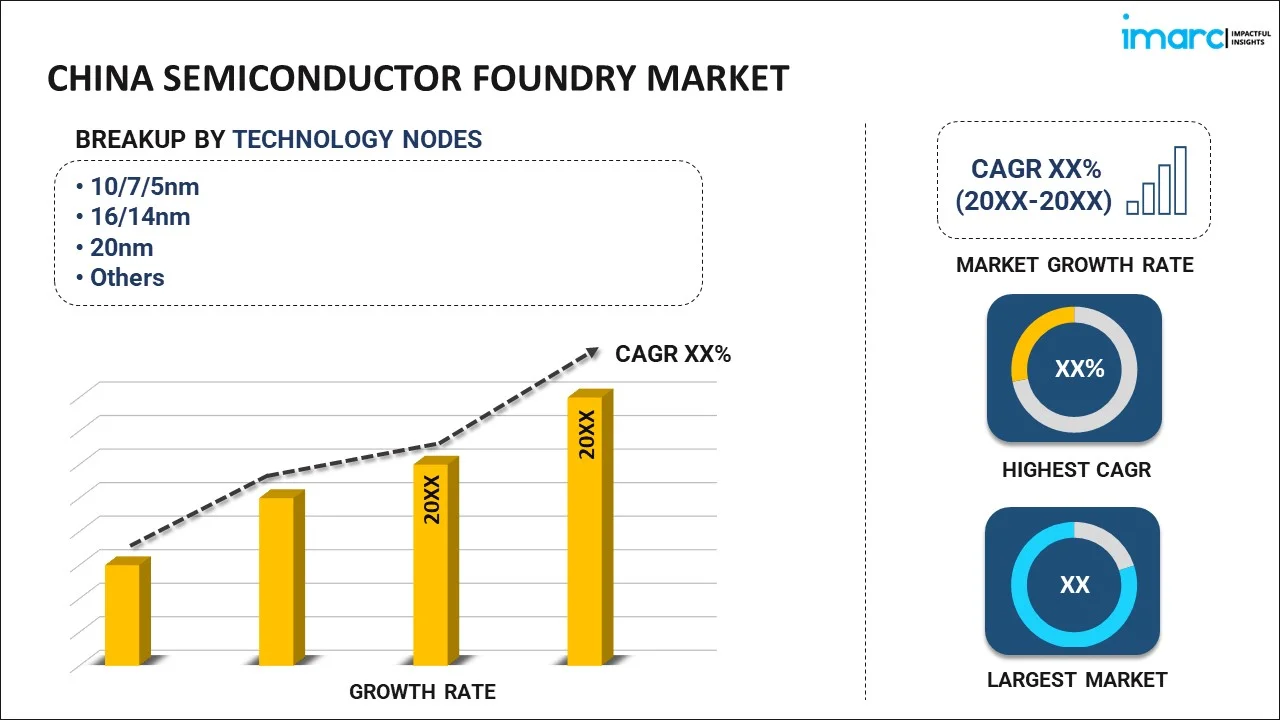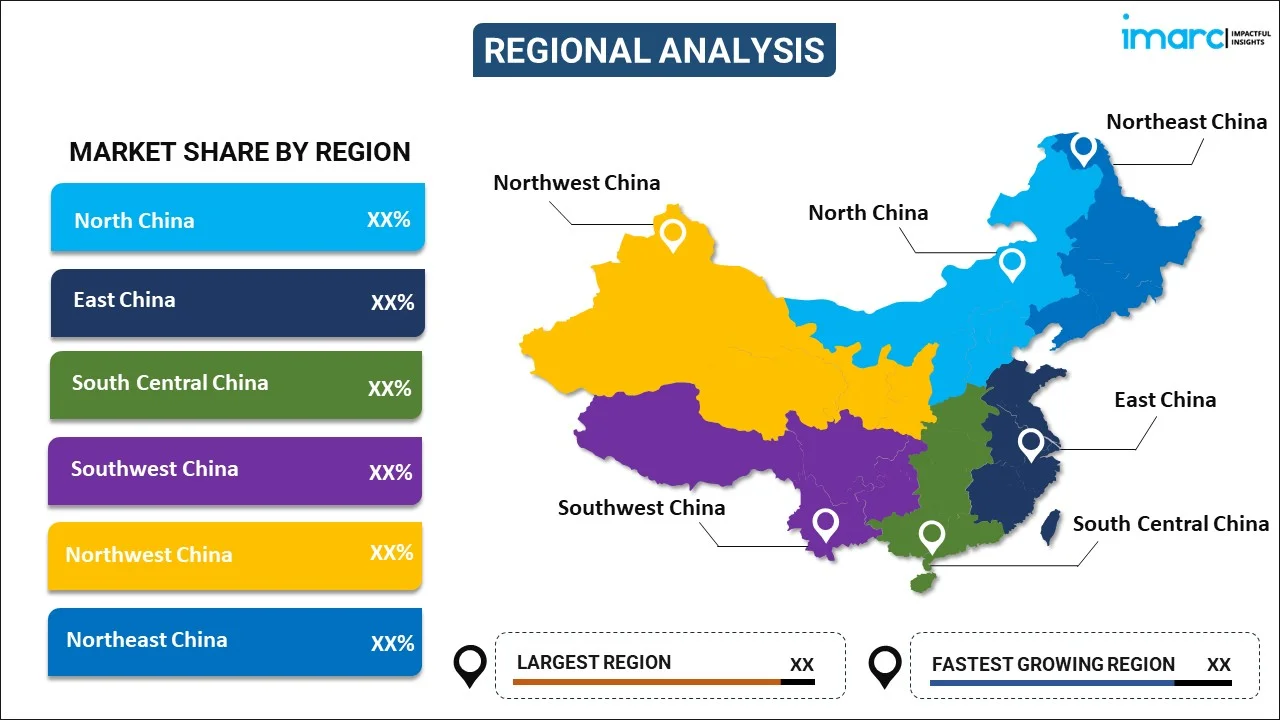
China Semiconductor Foundry Market Report by Technology Node (10/7/5nm, 16/14nm, 20nm, 45/40nmm, and Others), Foundry Type (Pure Play Foundry, IDMs), Application (Communication, Consumer Electronics, Computer, Automotive, and Others), and Region 2025-2033
Market Overview:
China semiconductor foundry market size reached USD 1,14,399.6 Million in 2024. Looking forward, IMARC Group expects the market to reach USD 1,93,275.7 Million by 2033, exhibiting a growth rate (CAGR) of 6% during 2025-2033. The rapid evolution of advanced applications, such as artificial intelligence (AI), 5G, autonomous vehicles, and augmented reality (AR), which can create new opportunities for semiconductor foundries, is primarily driving the market growth across the country.
|
Report Attribute
|
Key Statistics
|
|---|---|
|
Base Year
|
2024 |
|
Forecast Years
|
2025-2033
|
|
Historical Years
|
2019-2024
|
| Market Size in 2024 | USD 1,14,399.6 Million |
| Market Forecast in 2033 | USD 1,93,275.7 Million |
| Market Growth Rate (2025-2033) | 6% |
A semiconductor foundry is a specialized facility that manufactures integrated circuits (ICs) or chips for semiconductor companies that lack their production capabilities. These foundries provide a crucial service in the semiconductor industry by offering a dedicated space for designing, testing, and producing electronic components at scale. Foundries utilize advanced fabrication processes, such as photolithography and deposition, to create intricate semiconductor structures on silicon wafers. Companies, especially fabless semiconductor firms, partner with foundries to bring their chip designs to fruition without the substantial investment required for in-house manufacturing facilities. This collaborative model fosters innovation, cost-effectiveness, and efficiency in the development and production of a wide range of electronic devices, from smartphones to sophisticated computing systems.
China Semiconductor Foundry Market Trends:
The semiconductor foundry market in China is experiencing robust growth, driven by a confluence of factors. Firstly, the increasing demand for advanced electronic devices across diverse industries serves as a primary catalyst. As consumers seek more powerful and energy-efficient devices, semiconductor foundries play a pivotal role in meeting this demand by producing cutting-edge chips. Moreover, the escalating adoption of Internet of Things (IoT) technologies amplifies the need for customized semiconductor solutions, further propelling the market forward. Additionally, the rising complexity of semiconductor designs and the continuous quest for miniaturization contribute to the market's expansion. Semiconductor foundries, equipped with advanced manufacturing processes, become essential partners for companies aiming to develop smaller and more efficient electronic components. Furthermore, the growing trend towards outsourcing semiconductor production underscores another key driver. Many companies prefer leveraging the expertise of specialized foundries, allowing them to focus on core competencies and accelerate time-to-market for their products. Furthermore, the regional push towards 5G technology acts as a significant driver for the semiconductor foundry market. The deployment of 5G networks requires advanced semiconductor solutions to enable faster data processing, driving the demand for foundry services. In essence, these interconnected drivers create a dynamic landscape, fostering sustained growth and innovation in the semiconductor foundry market.
China Semiconductor Foundry Market Segmentation:
IMARC Group provides an analysis of the key trends in each segment of the market, along with forecasts at the country level for 2025-2033. Our report has categorized the market based on technology node, foundry type, and application.
Technology Node Insights:

- 10/7/5nm
- 16/14nm
- 20nm
- 45/40nm
- Others
The report has provided a detailed breakup and analysis of the market based on the technology Node. This includes 10/7/5nm, 16/14nm, 20nm, 45/40nmm, and others.
Foundry Type Insights:
- Pure Play Foundry
- IDMs
A detailed breakup and analysis of the market based on the foundry type have also been provided in the report. This includes pure play foundry and IDMs.
Application Insights:
- Communication
- Consumer Electronics
- Computer
- Automotive
- Others
The report has provided a detailed breakup and analysis of the market based on the application. This includes communication, consumer electronics, computer, automotive, and others.
Regional Insights:

- North China
- East China
- South Central China
- Southwest China
- Northwest China
- Northeast China
The report has also provided a comprehensive analysis of all the major regional markets, which include North China, East China, South Central China, Southwest China, Northwest China, and Northeast China.
Competitive Landscape:
The market research report has also provided a comprehensive analysis of the competitive landscape in the market. Competitive analysis such as market structure, key player positioning, top winning strategies, competitive dashboard, and company evaluation quadrant has been covered in the report. Also, detailed profiles of all major companies have been provided.
China Semiconductor Foundry Market Report Coverage:
| Report Features | Details |
|---|---|
| Base Year of the Analysis | 2024 |
| Historical Period | 2019-2024 |
| Forecast Period | 2025-2033 |
| Units | Million USD |
| Scope of the Report | Exploration of Historical Trends and Market Outlook, Industry Catalysts and Challenges, Segment-Wise Historical and Future Market Assessment:
|
| Technology Nodes Covered | 10/7/5nm, 16/14nm, 20nm, 45/40nmm, Others |
| Foundry Types Covered | Pure Play Foundry, IDMs |
| Applications Covered | Communication, Consumer Electronics, Computer, Automotive, Others |
| Regions Covered | North China, East China, South Central China, Southwest China, Northwest China, Northeast China |
| Customization Scope | 10% Free Customization |
| Post-Sale Analyst Support | 10-12 Weeks |
| Delivery Format | PDF and Excel through Email (We can also provide the editable version of the report in PPT/Word format on special request) |
Key Questions Answered in This Report:
- How has the China semiconductor foundry market performed so far and how will it perform in the coming years?
- What is the breakup of the China semiconductor foundry market on the basis of technology node?
- What is the breakup of the China semiconductor foundry market on the basis of foundry type?
- What is the breakup of the China semiconductor foundry market on the basis of application?
- What are the various stages in the value chain of the China semiconductor foundry market?
- What are the key driving factors and challenges in the China semiconductor foundry?
- What is the structure of the China semiconductor foundry market and who are the key players?
- What is the degree of competition in the China semiconductor foundry market?
Key Benefits for Stakeholders:
- IMARC’s industry report offers a comprehensive quantitative analysis of various market segments, historical and current market trends, market forecasts, and dynamics of the China semiconductor foundry market from 2019-2033.
- The research report provides the latest information on the market drivers, challenges, and opportunities in the China semiconductor foundry market.
- Porter's five forces analysis assist stakeholders in assessing the impact of new entrants, competitive rivalry, supplier power, buyer power, and the threat of substitution. It helps stakeholders to analyze the level of competition within the China semiconductor foundry industry and its attractiveness.
- Competitive landscape allows stakeholders to understand their competitive environment and provides an insight into the current positions of key players in the market.
Need more help?
- Speak to our experienced analysts for insights on the current market scenarios.
- Include additional segments and countries to customize the report as per your requirement.
- Gain an unparalleled competitive advantage in your domain by understanding how to utilize the report and positively impacting your operations and revenue.
- For further assistance, please connect with our analysts.
 Request Customization
Request Customization
 Speak to an Analyst
Speak to an Analyst
 Request Brochure
Request Brochure
 Inquire Before Buying
Inquire Before Buying




.webp)




.webp)












